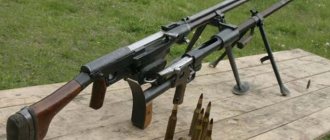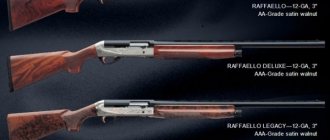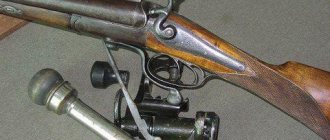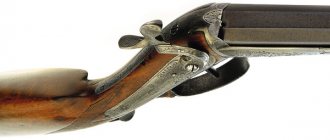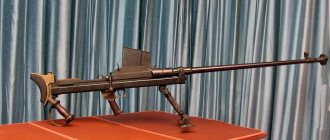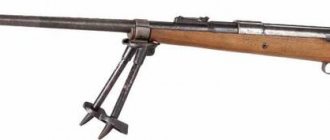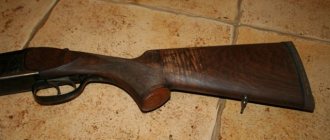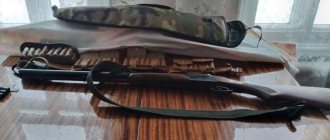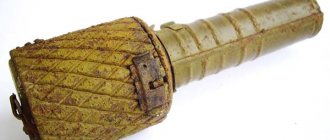Review article on the PTRS anti-tank riflePhoto selection-1: PTRD and PTRS shotguns Photo selection-2: Detailed photos of the PTRD Photo selection-3: Photos of soldiers with the PTRD Photo selection-4: PTRD with an optical sight Photo selection-5: PTRD in the Donbass Photo selection-6: Detailed photos of the PTRD
A little background
Before anti-tank rifles appeared in the Soviet army, a whole chain of previous events took place. The history of the creation of this weapon is not much different from its brother, the Simonov PTRS, and even repeats it at times.
In the USSR, work on creating their own anti-tank rifles began in the early 30s, and at the end they were accelerated as much as possible. A competition for the development of anti-tank missiles, with a caliber of 20-25 mm and a weight of up to 35 kg, was announced on March 13, 1936.
Degtyarev PTRD anti-tank rifle
In November 1938, as a result of an analysis of the 1936-1938 competition, the Art Committee developed the main criteria for anti-tank rifles that would meet modern requirements for conducting maneuverable combat. Subsequently, work on the creation of anti-tank rifles was slowed down due to the lack of the necessary cartridge. However, soon the first sample of a 14.5 mm cartridge was created.
In 1939, the PTR system of Rukavishnikov was presented for testing. But work on the creation of a 14.5 mm cartridge was not curtailed and actively continued. At the same moment, the leadership of the People's Commissariat of Defense formed the false opinion that in the coming war, anti-tank rifles would be useless due to the decent frontal armor of tanks, which, in their opinion, would reach at least 60-80 mm. And how wrong they were then... But that's another story.
It took the Soviet command more than a year to realize the value and necessity of the PTR, and already on June 23, 1941, it was decided to resume work on the creation of the PTR.
Reviews about PTRS
Igor Teryaev, historian: “PTRS was created in the shortest possible time in a difficult situation for the country. This weapon was reliable and mobile. Since the development of the model was carried out in the shortest possible time, shortcomings remained. Throughout the Great Patriotic War, the anti-tank rifle was constantly improved, its characteristics were constantly improved.”
Stepan Perevzev, historian: “In wartime conditions, during the mass production of these weapons, problems sometimes arose when shooting. The most unpleasant were the transverse ruptures of the cartridges. As a rule, this happened in cases where the cartridge was a little more powerful than it should have been. To correct this, weapon designers made improvements that gradually reduced the risk of such situations occurring.”
Sergei Timoshin, weapons lover: “High mobility and good armor-piercing capability made the PTRS very popular among soldiers and officers of the Red Army. It was used not only to fight tanks, but also to destroy other types of equipment, as well as long-term firing points.”
The PTRS was developed in less than a month. Already in November 1941 it was put into service. Practicality, efficiency, and manufacturability have made it one of the most popular models in this niche of weapons. As the thickness of tank armor increased, the popularity of PTRS decreased and their production ceased in 1945.
Historical information
In the pre-war years, the USSR command focused its main emphasis on creating powerful anti-tank guns like the ZIS-2 or F-22.
Photo of the PTRD anti-tank rifle
As it turned out in reality, the bulk of German armored vehicles do not have serious armor and can easily be penetrated by 12.7 mm armor-piercing bullets from the DShK machine gun. For this reason, J.V. Stalin set the task for the People's Commissariat of Armaments to create an anti-tank rifle chambered for 14.5 mm within a month. The weapon had to be both effective, simple and cheap. Degtyarev took on the development at the same time. Simonov and Rukavishnikov.
The PTRD was developed at KB-2. Then 2 weapon development groups were created. One was headed by A.A. Dementyev. with technicians Krekin and Garanin. They developed an anti-tank rifle with a short barrel stroke. The second group consisted of Degtyarev himself and he developed a gun with a long barrel stroke based on Vladimirov’s gun, which was never accepted for service.
Both developments were presented to the Main Art Directorate. As a result of the testing carried out there, a verdict was made - Dementyev’s gun needs to be modified and made single-shot, while Degtyarev’s gun has a huge number of shortcomings and is quite heavy. As a result, a single-shot version of the PTRD with cartridge ejection and automatic shutter opening was adopted.
As a result of field tests, the PTRD has proven itself well as a weapon that effectively penetrates the armor of both Soviet and German tanks. The gun was adopted by the Red Army on August 29, 1941.
This is interesting: the PTRD was an extremely technologically advanced weapon and could almost entirely be manufactured on a lathe. The same cannot be said about PTRS.
PTRD
Serial production of PTRD began on September 22, 1941 at the Kovrov Arms Plant, and 2 months later they began to be produced at the Izhevsk Machine Plant.
In total, 17,688 weapons were produced in 1941, and 184,800 the following year. During all the years of the war, the production of PTRDs amounted to 281,111 units. Production of the Degtyarev gun was discontinued in December 1944.
Design features of PTRD-41
The gun, designated PTRD-41, was very simple in design, quite technologically advanced and cheap to manufacture. It was a system with manual loading of the cartridge and automatic opening of the bolt after the shot, which significantly increased the rate of fire and facilitated the process of removing spent cartridges.
Anti-tank rifle of the Simonov system - PTRS-41
Gun design
The PTRD shotgun was highly technologically advanced and has a classic layout. There is a bolt stop on the receiver. At the bottom of the box there is a trigger mechanism, which consists of a trigger lever, a hook, a sear and two springs. The receiver has two windows on the outside: the lower one for ejecting the spent cartridge case and the upper one for inserting the cartridge. It also has a cutout for moving the bolt handle and a platform with a protrusion for connecting to the butt. Inside it there are two longitudinal grooves and protrusions, as well as a channel for placing the shutter.
PTRD design
The rifle bolt consists of a firing mechanism and a frame, which consists of the following parts:
- a channel for the passage of the striker;
- handles;
- cups for placing the cartridge head;
- reflector and spring sockets;
- two lugs for locking the barrel;
- ejector slot;
- a beveled cutout that pulled the firing pin back when the bolt was opened;
- an annular groove for the possibility of coupling between the bolt frame and the impact mechanism.
- two holes to allow the removal of gases that have entered the inside of the shutter.
The impact mechanism of the Degtyarev PTRD shotgun consists of:
- drummer;
- mainspring, which sends the firing pin forward;
- a restrictive tube blocking the retraction of the striker back;
- coupling connecting the bolt to the impact mechanism;
- striker couplings;
- striker.
The shotgun barrel has 8 grooves from left to right and is equipped with a muzzle brake to reduce recoil, a connector for attaching a bipod and a carrying handle. At the rear of the barrel there is a sight bracket, and in front there is a front sight base with a front sight.
PTRD shotgun
PTRD sight - bracket, rear sight with slot and spring. The rear sight has two positions - for shooting at distances up to 400 m and at distances from 400 to 1000 m. The position of the rear sight is adjusted by rotating it 90 degrees (late PTRD production) or by moving it up and down along the bracket hole (early production) .
PTRD cartridges
The PTRD uses the same cartridges as the PTRS - BS-41 with an armor-piercing incendiary bullet (metal-ceramic core made of tungsten carbide) and an armor-piercing incendiary cartridge B-32 with a steel core.
"Tankgewer" against steel monsters
The First World War became the theater of baptism of fire for a new weapon - tanks. By the end of the war, avalanches from hundreds of armored vehicles rolled into German positions. Germany, which did not pay enough attention to the creation of tanks, took the path of countering the new threat through the creation of anti-tank weapons. An anti-tank gun, factory-made grenade clusters, and a Tankgewer M1918 anti-tank rifle, or Mauser T-gewer.
Tankgewehr M1918
Source: pinterest.ru
This is a heavy (almost 18 kg) rifle chambered for the new 13 mm machine gun cartridge. The machine gun itself, however, did not have time to be produced en masse, but the rifle turned out to be easy to manufacture and quickly took root among the troops. Each company had such a deadly “club”, and in total, before the end of the war, the German infantry received more than 15 thousand of these rifles. And now the armor of the tanks, which had previously been invulnerable to gunfire, was hit by serious bullets that could penetrate any tank of that time at a distance of 300 meters. This was quite enough for the trench conditions of war, but the armor effect of the bullet, if it did not hit the crew, turned out to be low. The war ended, and gunsmiths did not have time to develop a new threat to tanks. But a new big war was approaching.
Features of application
The first 300 units of the released PTRD were sent to the 16th Army of Major General K.K. Rokossovsky, which defended the northwestern approaches to the capital Moscow.
Anti-tank rifle PTRD and PTRS
For the first time in combat, the PTRD 41 rifle was used by soldiers of the 1075th Infantry Regiment of the 316th Infantry Division. Already in November 1941, the first 2 enemy tanks were knocked out in the area of Shiryaevo and Petelino, and a little later another 4 units in the area of the village of Lugovaya.
It was the PTRD 41 that was responsible for the temporary stoppage of the supply of Lendlease Sherman tanks from the USA to the USSR for the reason that the gun at a distance of 500-1000 meters was capable of piercing them in the side projection with the BS-41 cartridge. Later, the Americans strengthened the side armor of the vehicles.
This is interesting: by the end of the war, only 111 PTRD units were in service with the USSR rifle divisions.
The PTRD also caused a lot of trouble for the Germans. Both light armored vehicles and tanks, in particular their chassis, were disabled. To protect it, additional armor plates had to be installed on armored vehicles.
A German soldier inspects captured PTRDs
During World War II, the PTRD was actively used as a means of air defense. To shoot at aircraft, a device similar to a slingshot was installed on the parapet of the trench. There is a known option of using a cart axle with a wheel, which was buried in the ground. This approach ensured excellent horizontal aiming of the gun. A huge contribution to shooting from an anti-tank rifle was made by an armor-piercing shooter of the 284th Infantry Division, who drew up a scheme for shooting from anti-tank rifles at aircraft, which military units willingly used.
In the spring of 1944, the 5th Guards Motorized Rifle Brigade also developed a device that made it possible to use 14.5 mm PTRD on vehicles, which created mobile anti-tank installations from them. The device was approved for use by the military.
Firing PTRD at airplanes
At the end of the war, all PTRDs were removed from service and remained in storage, and in the 50-60s a small number were transferred to the hunting farms of the North for whale hunting.
This is interesting: during the Korean War, American Army Captain William Brophy managed to convert a captured PTRD into a large-caliber sniper rifle with an optical sight chambered for 12.7x99 mm NATO cartridge.
The soldiers loved weapons and took care of them. It turned out really good - easy to produce, cheap, effective and trouble-free.
Degtyarev's anti-tank rifle appears quite often in films, literary works and computer games.
Anti-tank crew with PTRD
The gun has not been forgotten even today - it was noticed during the armed conflict in the East of Ukraine - it was used by both DPR fighters in the Slavyansk area and units of the Ukrainian Armed Forces.
Soviet anti-tank infantry weapons of Degtyarev and Simonov. About opportunities and weaknesses
The BZ-39 bullet was also used, differing from the B-32 in its shorter length and weight. Due to its worse characteristics compared to the B-32 and BS-41 bullets, the BZ-39 bullet was produced for a short time. All bullets were loaded into a brass wafer-shaped bottle case.
PTR designed by Degtyarev
Chambered for the 14.5 mm N.V. cartridge. Rukavishnikov developed a fairly successful self-loading gun with a rate of fire of up to 15 rounds/min. In August 1939, it successfully passed tests, and in October it was put into service under the designation PTR-39. But mass production was never established. It was a PTR on a wheeled carriage (motorcycle wheels) and with a crew of four people. There was a bipod version, photographs of which can be found in books, but it was impossible to shoot from it due to the large weight of the gun. Together with low armor penetration, these factors led to the abandonment of the Rukavishnikov anti-tank rifle.
It is no wonder that in 1941 they wrote in the recommendations for the use of anti-tank rifles: “The cartridge with the BZ-39 bullet for a 14.5 mm gun and the B-32 cartridge for a 12.7 mm gun penetrates only the lower side part of the body between the first and second rollers, hitting the driver, and between the fifth and sixth rollers, piercing the radiator.”
The reason for this was the erroneous opinion of the head of the State Autonomous Institution G.I. Kulika. He believed that the potential enemy - Nazi Germany - already possesses armored vehicles with reinforced armor, as a result of which even 45-mm and 76-mm anti-tank guns, not to mention anti-tank guns, would not be effective against German tanks. On August 26, 1940, he completely excluded the anti-tank rifle from the weaponry, and the 45-mm and 76-mm guns were no longer produced. In fact, it turned out that the armor of the German tanks, hordes of which invaded the USSR on June 22, 1941, did not exceed 50 mm, and most enemy armored vehicles could even be penetrated by an armor-piercing bullet from a 12.7-mm DShK machine gun.
PTR designed by Degtyarev
Such a famous artillery designer as Grabin also made his contribution to the ban on anti-tank rifles in the Red Army. In his conclusion dated November 11, 1940, in response to Kulik’s request, Grabin indicates that the PTR will never be able to replace a full-fledged anti-tank weapon. Among the reasons, he named: 1) the vulnerability of the crew due to the lack of an armor closure on the PTR 2) the large length of the gun, which made it inconvenient for transportation 3) the PTR does not allow taking the correct lead, making corrections in shooting in case of a miss, or accurately aiming the weapon at vulnerable spot of the tank. Two other reasons were also given. An anti-tank rifle will not achieve a sufficiently strong armor effect unless its caliber is increased to 20-25 mm. And in this case, its weight will be comparable to the weight of an anti-tank gun. In addition, emphasis was placed on the high cost of such weapons, since drilling long thin barrels and making rifling in them is extremely expensive and labor-intensive.
The war quickly showed that the Soviet infantry was left almost defenseless against German tanks. Already in July 1941, as a temporary measure at the suggestion of engineer V.N. Sholokhov in the workshops of Moscow Higher Technical University named after. Bauman and other engineering universities in Moscow have established the assembly of a single-shot anti-tank rifle (the so-called Sholokhov anti-tank rifle) chambered for the 12.7-mm DShK cartridge. The simple design was copied from the old German Mauser PTR with the addition of a muzzle brake, a shock absorber on the butt and the installation of a lightweight folding bipod. To fire from it, cartridges with armor-piercing incendiary bullets B-32 and armor-piercing incendiary bullets BS-41 were used. The initial speed of the bullets was 870 and 850 m/s, respectively. Cartridges with the BS-41 bullet were produced in small quantities. Other DShK cartridges with B-30 and BZT bullets could also be used. However, these ersatz 12.7 mm caliber guns were incomparable in effectiveness to 14.5 mm caliber weapons and were discontinued by the beginning of 1942.
Firing from a PTRD at a Pz III tank
German tanks were rushing to the east. And the Soviet infantry remained practically unarmed in the face of the enemy. In order to speed up work on an effective and technologically advanced 14.5 mm PTR, I.V. Stalin suggested entrusting the development to “one more, and for reliability - two designers.” The assignment was issued in July 1941 to V.A. Degtyarev and S.G. Simonov. A month later, designs ready for testing appeared - only 22 days passed from the moment the task was received to the first test shots. Of the two samples developed by Degtyarev, a simplified, single-shot, with an incomplete automation cycle was approved. Already on August 29, both guns - single-shot designs by V.A. Degtyarev (PTRD) and five-shot design by S.G. Simonov (PTRS) were adopted by the Red Army and put into mass production.
In August 1941, a 14.5-mm cartridge with an armor-piercing incendiary bullet BS-41 weighing 64.5 g and a length of 51 mm with a metal-ceramic core was also adopted for service, which pierced armor 30 mm thick at an angle of 70° at a distance of 350 m. The production of bullets began only in October. Like the Germans, the USSR considered the idea of placing a capsule with the irritating substance CAF (chloroacetophenone) in the bottom part of the BS-41 core. The bullet was called “armor-piercing incendiary chemical.”
Firing from a PTRD at an armored personnel carrier
But let's get back to the guns. The PTRD consisted of a barrel with a cylindrical receiver, a longitudinally sliding rotary bolt, a stock with a trigger box, impact and trigger mechanisms, sights and a bipod. The box-shaped active muzzle brake absorbed up to 2/3 of the recoil energy. After the shot, the movable system, which included the barrel, receiver and bolt, moved back, the bolt handle ran onto the carbon profile mounted on the butt and turned, unlocking the bolt. After the barrel stopped, the bolt moved back by inertia and stood on the bolt stop, the reflector pushed the cartridge case into the lower window of the receiver. The moving system was returned to the forward position by a shock absorber spring. Inserting a new cartridge into the upper window of the receiver, chambering and locking the bolt was done manually. The butt had a soft cushion, a wooden rest for holding the weapon with the left hand, a wooden pistol grip, and a “cheek.” Folding stamped bipods were attached to the barrel. A carrying handle was attached to the barrel with a clip. A minimum of parts, the use of a stock pipe instead of a frame simplified the production of anti-tank rifles, and the automatic opening of the bolt increased the rate of fire. Sights were placed to the left on brackets and included a front sight and a rear sight at ranges of up to 600 m and above. The accessory included two canvas bags holding 20 rounds each. The total weight of the PTRD with ammunition is about 26 kg. In battle, the gun carried one or both crew numbers. The first batch of 300 PTRDs was completed in October and sent to Rokossovsky's 16th Army in early November. They were first used in battle on November 16th. By December 30, 1941, 17,688 PTRDs had been produced, and in 1942 - 184,800, which made it possible not only to satisfy the needs of the troops, but also to create a reserve of anti-tank rifles by the end of the year. The PTRD anti-tank rifle was a powerful weapon - at a distance of up to 300 m, its bullet penetrated armor 35-40 mm thick. The incendiary effect of the bullets was also high. Thanks to this, it was successfully used throughout the Second World War. Its production was discontinued only in January 1945.
The Ba-64 armored car with the turret removed is armed with a PTRD
The self-loading PTRS was created on the basis of the experimental Simonov self-loading rifle mod. 1938. In fact, the PTRS was an enlarged self-loading rifle. To operate the automation, Simonov used the energy of powder gases, partially removed from the barrel after the shot. The PTRS consisted of a barrel with a muzzle brake and a gas chamber, a receiver with a butt, a bolt, a trigger guard, reloading and firing mechanisms, sights, a magazine and a bipod. The bore was similar to the PTRD. The barrel was locked by tilting the bolt frame downwards. Unlocking and locking was controlled by the bolt stem with a handle. When the cartridges were used up, the bolt, mounted in the receiver, came to a stop. The magazine with a lever feeder was hinged to the receiver, its latch was located on the trigger guard. The cartridges were arranged in a checkerboard pattern. The magazine was loaded with a clip (pack) of 5 rounds with the lid folded down. The accessory included 6 clips. Sighting devices included a front sight with a fence and a sector sight, notched from 100 to 1500 m every 50 m. The maximum sighting range of fire from a gun was 1500 m. The best results of shooting at tanks were achieved at a distance of up to 300 m. At this range, a gun bullet pierced armor 35 mm thick. The PTR had a wooden butt with a soft cushion and shoulder pad, and a pistol grip. The narrow neck of the butt was used for holding with the left hand. Folding bipods were attached to the barrel using a clip (swivel). There was a carrying handle. In battle, the PTR transferred one or both crew numbers. During the hike, the disassembled gun - barrel and receiver with butt - was carried in two canvas covers. Thanks to automatic reloading, the shooter could fire at enemy combat vehicles moving at high speed without wasting time on reloading.
The production of the PTRS was simpler than the Rukavishnikov PTR (one third fewer parts, 60% less machine hours, 30% less time), but much more complex than the PTRD. The production of PTRS required special preparation and material costs. In 1941, only 77 PTRS were produced, in 1942 - 63308. After tests on August 29, the State Defense Committee decided to adopt them.
PTR designed by Simonov
Of course, the speed of mastering new weapons in production and the lack of time for comprehensive field testing made their presence felt. With PTRD, it was difficult to remove spent cartridges; with PTRS, double shots occurred. By the summer of 1942, all these shortcomings had been eliminated.
In addition to Simonov and Degtyarev, other designers also took part in the competition for the PTR. A special group from OKB-2 led by A.A. Dementiev and two technicians G.S. Garanin and S.M. Krekin developed a shotgun with a short barrel stroke chambered for 14.5x114 cartridge. The PTR developed by Dementyev’s group, although somewhat inferior to Simonov’s gun in terms of rate of fire (seven rounds per minute versus ten), was noticeably lighter (17.3 kilograms versus 24). Dementyev's gun was tested at the training ground and showed good results, but an anti-tank gun designed by Degtyarev, modified according to the GAU's comments, was adopted for service.
The PTR troops in appropriate quantities came at a very opportune time: during the battle near Moscow in the area of the villages of Petelino - Shiryaevo, eight armor-piercing guns, shooting from 150-200 m, destroyed two German tanks. Subsequent battles confirmed the high quality of the weapon. Thus, in the battle for Lugovaya station, one of the destroyed enemy tanks had 18 through holes. Anti-tank rifle crews successfully fought with almost all types of Wehrmacht armored vehicles. If before the war the PTR was considered a company-level weapon, then in December 1941 the PTR platoon was introduced at the regimental level. In total, the division had 89 anti-tank rifles throughout the state. Already in 1942, the division's staff included 279 anti-tank rifles.
However, by 1943, the Germans had heavily armored tanks and self-propelled guns, and anti-tank guns could no longer adequately fight them. To combat these machines, it was decided to create a more powerful anti-tank rifle. The PTR of Blum's design aroused interest. It was developed for a 14.5-mm caliber cartridge (14.5x147), specially created on the basis of a 23-mm aircraft cannon cartridge case, which made it possible to give the armor-piercing bullet an initial speed of 1500 m/s. The new PTR was significantly superior to the PTRD and PTRS in service and represented a reliable means of combating medium tanks such as Pz-III and Pz-IV, allowing it to penetrate 55 mm armor from a distance of up to 100 m. However, the Blum PTR was not adopted for service. An important role was played by the extremely high pressure in the barrel, which led to its rapid wear, and this was uneconomical. In addition, the new anti-tank rifle was useless against the Tigers, Panthers and Pz-IVs, which received enhanced armor and anti-cumulative screens (“aprons”).
Romania, 1944. Fighter with PTRS
Until the end of the war, anti-tank rifles were used quite effectively against light armored vehicles, gun crews, machine gun nests, and pillbox embrasures. They also fired at enemy aircraft from anti-tank guns. There is evidence that armor-piercing aircraft A. Denisov shot down two fascist bombers near Orel on July 14 and 15, 1943. The Germans did not disdain Soviet anti-tank guns either, because the PTRS and PTRD were superior in their characteristics to the German anti-tank guns. The PTRS rifles captured in battles with the Red Army had the German designation PzB 783(r).
In total, from 1941 to 1945, about 400,000 PTRs were produced.
We should also talk about the shortcomings of Soviet anti-tank rifles. They had the bad property of raising a cloud of dust or snow when firing, thereby unmasking the crew’s position. There was even a saying among the soldiers about PTR shooters: “The fishing rod is long, life is short.” When fighting tanks, the low penetration capabilities of the guns forced them to fire from minimal distances, which was very difficult psychologically. They were characterized by the PTR disease of other countries: the weak armor effect of the bullet. Yes, the bullet pierced the armor of tanks, but if there was no crew member or vital unit behind the armor, then this penetration did not cause damage to the tank. In general, anti-tank guns were more of a half-measure aimed at quickly making up for the losses of the summer of 1941 in anti-tank weapons and played the role of more of a psychological tool for infantrymen in the trenches. In terms of basic indicators, Soviet anti-tank missiles were superior to their foreign counterparts, probably for the reason that they were created during the war, based on the experience gained, and not before it began.
A fighter with PTRS fires from cover
After the war, anti-tank rifles were almost immediately replaced by the RPG-2 grenade launcher. However, their service did not end there. PTRS (and according to some reports, PTRD), which are in service with the North Korean army, received the nickname “buffalo guns” from American tankers. It was given because bullets fired from an anti-tank rifle easily penetrated the armor of American M24 Chaffee tanks. PTRs also fought in Vietnam and in numerous African and Middle Eastern conflicts. Until now, a Soviet anti-tank rifle made in 1941 can penetrate the armor of, for example, the M113 armored personnel carrier in service with the US Army (and not only others).
The armies of the world's leading powers quickly abandoned anti-tank rifles in favor of hand-held grenade launchers. However, modern military realities have led to the unexpected rehabilitation of the PTR, although in a slightly different capacity. Equipped with a powerful optical sight and with a more effective cartridge, such heavy sniper rifles could perform a lot of functions: as a sniper rifle for shooting from extended distances, as a counter-terrorist weapon for hitting an enemy in body armor, as an anti-sniper weapon, a weapon for destroying light armored vehicles (or equipment tanks), low-flying aircraft and helicopters, remote mine clearance equipment. During the Cold War, the USSR seriously thought about creating such rifles for saboteurs that would destroy American missiles immediately after they launched and exited the launch silo.
PTR designed by Sholokhov
Found a typo? Select a fragment and press Ctrl+Enter.
Tags: Small arms
Previous article Kalashnikov created small-sized Malysh assault rifles for self-defense
Next article “Marker” son of “Aspid”. New Russian self-loading training pistol
Provided by SendPulse
Likes 0
Disassembly and assembly of PTRD
To completely disassemble the PTRD it is necessary:
- Place the weapon on the bipod, remove the bolt and disassemble it.
- Separate the bipod.
- Separate the butt.
- Disassemble the trigger.
- Separate the bolt stop.
To perform partial disassembly of a weapon, you must complete step 1 of complete disassembly.
Anti-tank crews of PTRD and PTRS
Assembly of the Degtyarev PTRD is carried out in the reverse order.
PTRD equipment: gun, wrench, screwdriver, composite cleaning rod, brush, oiler. Also included with the gun were 2 canvas cartridge pouches for 20 rounds, 2 canvas covers to protect the gun and a record form.
Advantages and disadvantages of the model
Advantages and disadvantages
High sighting range
Good armor penetration.
Simplicity and reliability in operation.
High survivability of weapons.
In rare cases, transverse ruptures of cartridges could occur.
Unplanned double shots could be carried out.
Sometimes there is a delay in the shot.
During the war, during the active use of the anti-tank rifle, its features were clearly visible. Overall, attitudes towards PTRS were positive. The military noted its following advantages:
- Easy to operate and maintain.
- Long sighting range.
- High efficiency when performing combat missions.
During operation, the following disadvantages were noted:
- There was a possibility of transverse rupture of the cartridges.
- Sometimes double shots could occur.
- There was a delay when firing.
The designer constantly carried out improvements to the PTRS, but these shortcomings were not completely eliminated. Gradually, Germany increasingly used heavily armored vehicles. Therefore, the use of PTRS and PTRD became less effective.
Performance characteristics
| Weight, kg | 17.3 (unloaded) 0.2 (cartridge) |
| Length, mm | 2000 |
| Barrel length, mm | 1350 (with chamber) |
| Cartridge | 14.5 × 114 mm |
| Caliber, mm | 14,5 |
| Rate of fire, rounds/min | 8-10 (combat rate of fire |
| Initial bullet speed, m/s | 1020 |
| Sighting range, m | 1000 |
| Maximum range, m | 800 (effective) |
| Type of ammunition | single shot |
| >Sight | open, with two installations at ranges up to 400 m and from 400 m to 1000 m |
Results
The PTRD appeared in time among Soviet soldiers and helped defend the country in the first months of the war, holding back the light tanks of the German troops. Even after the appearance of more protected tanks, the Germans PTRDs against lightly armored vehicles and low-flying aircraft, as evidenced by many photographs from the Second World War. In our time PTRDs were often used in the Donbass; perhaps the guns were in military warehouses for long-term storage since the Second World War. Captured PTRDs were happily used by German troops under the designation Panzerbüchse 783. Some of the guns were transferred to Polish and Bulgarian troops. After WWII, PTRDs were used in the Korean War of 1950-1953 (
,
).
Technical characteristics of PTRD-41
| Number of shots | 5 rounds |
| Barrel caliber | 14.5x114 mm, 1350 barrel length |
| Combat rate of fire | 8-10 rounds per minute |
| Maximum rate of fire | no data |
| Sighting range | 1000 meters |
| Maximum firing range | 2500 meters against unarmored targets |
| Effective shooting | 800 meters |
| Initial departure speed | 1020 m/s |
| Automation | manual reloading, bolt circuit |
| Weight | 17.3 kg+1.1 kg (20 rounds) |
| Bullet energy | 29.8 kJ |
| Dimensions | 2000 mm |
Number of PTRD and PTRS produced
| Weapons factories | PTR type | 1941 | 1942 | 1943 | 1944 | Total |
| Plant No. 2 NKV Kovrov | PTRD | 16038 | 144959 | 78463 | 239460 | |
| Plant No. 74 NKV Izhevsk | PTRD | 1611 | 40040 | 41651 | ||
| PTRS | 2 | 29416 | 42521 | 19436 | 91375 | |
| Plant No. 614 NKV Saratov | PTRS | 75 | 35227 | 38346 | 13539 | 81187 |
| Plant No. 385 NKV Zlatoust | PTRD | 17726 | 5719 | 6334 | 12053 | |
| Total | 17726 | 249642 | 165049 | 39309 | 471726 | |
And
